#ancient anatolia
Text

A well-preserved mosaic from the temple of Apollo
This mosaic is the original from the temple of Apollo at the Ancient Letoon, a religious Anatolian complex devoted to Leto and Her children - patron Gods of Lycia. Letoon is considered to have been around before the Hellenic influence in the region, though over time it has become a place of mixing of many cultures and eras.
The mosaic, for example, dates back to around 400 BCE when the temple to Apollo within the Letoon complex was built by King Erbinna, a Lycian ruler. The solar symbol in the middle is believed to symbolize Lycia, the land of the Sun. The quiver of arrows and the lyre are for Apollo as well.
Currently, the original is at the museum in Fethiye, Turkey. The mosaic presented at the site is a modern replica created after the original was removed.
Photo source: 🏺
#ANTIGÜEDADES 💎#ancient art#ancient anatolia#ancient lycia#ancient turkey#letoon#mosaic#apollo#greek mythology#greek gods#anatolian gods
33 notes
·
View notes
Text
For all that people rave about how impressive and important the rosetta stone is, they conveniantly forget about similar trilingual carvings like the xanthian obelisk and behistun.
Xanthian obelisk: It‘s a funerary marker for a dynast of Achaemenid Lycia (likely Kherei or Kheriga) dating back to the 4th C. BCE. It‘s located in the acropolis of Xanthos, the capital city of ancient Lycia. It is inscribed with ANCIENT GREEK, LYCIAN and MILYAN.
Behistun: Three panels of OLD PERSIAN, BABYLONIAN and ELAMITE are inscriped into the cliff edge overlooking the road connecting Babylon and Ecbatana, the capital cities of Babylonia and Media. It was commisioned by King Darius I of Persia and details how his ascension to the throne was chosen by the god Ahuramazda.
There are many other multilingual inscriptions like these that are largely unknown despite many having been preserved better than the rosetta stone. I would greatly appreciate if people were less euro-centric. For more information on Behistun: ‚thin end of the wedge‘ podcast have done an episode talking to one of the assyriologists working on it.
3 notes
·
View notes
Link
14 notes
·
View notes
Photo

Baltalı Amazon, lahit parçası - M.S 1-2. yy - Güney Kent Duvarı, Afrodisias, Aydın, Türkiye
Amazon with axe - a piece of a tomb - 1st - 2nd Century AD, South City Wall, Aphrodisias, Aydın, Türkiye
#ancient#antik#lahit#tomb#ancient rome#Ancient Anatolia#antik kent#Afrodisias#Aphrodisias#amazon#axe#anatolia#anadolu#archeology#arkeoloji
2 notes
·
View notes
Text
It is believed that the Greek term Asia (Ἀσία) arose from Aswiya/Assuwa. This has been argued by some as a record of an offering made to a foreign deity holding a place of worship in Messenia, perhaps in connection with the associated women of Aswiya now working for Pylos.
A significant number of deities are attested on Mycenaean tablets, usually in contexts of dedication of sacrifices and goods. Some of these deities are known to us from the 1st millennium BC, while others are specifically Mycenaean.
Assuwa is a geographical term used in Hittite documents for a region in Western Anatolia (Asia Minor), most famously it was used as political term to describe the “Assuwan Confederacy” formed by 22 states against the Hittite king Tudhaliya I/II.
One of the most frequent Mycenaean theonyms is "Potnia" which probably represents more than one female deity, heirs of the Great Mother. Thus we have Potnia daburinthoyo (lady of the labyrinth), Potnia Aswija (lady of Asia), Sitopotnia (lady of grain), Potnia hikkweia (lady of horses). Kwerasia (Therasia) must be equated with Potnia of beasts (lady of wild beasts), while Thehia Mater (Divine Mother or Mother of the gods) must also belong to the same religious sphere.
6 notes
·
View notes
Text
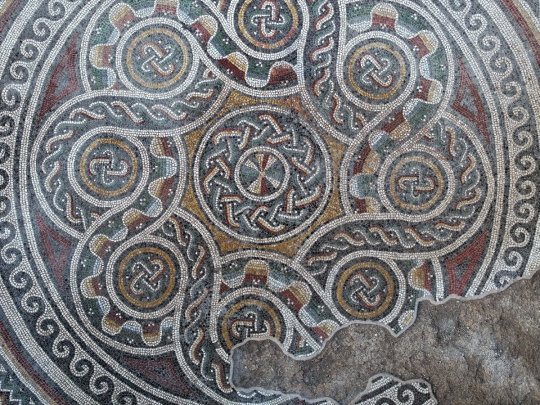
The Largest Ancient Floor Mosaic in Turkey Uncovered
The structure with the largest floor mosaic in Cappadocia and Central Anatolia Region was unearthed during the excavations carried out in Örenşehir District of İncesu district of Kayseri province, located in the center of Türkiye.
During ongoing excavations, new mosaics were unearthed from the villa, which is estimated to have been built in the 4th century.
The excavations are carried out under the direction of Nevşehir Hacı Bektaş Veli University, Department of Art History, Lecturer Dr Can Erpek.
Kayseri Provincial Director of Culture and Tourism, Şükrü Dursun, stated that the excavation began three years ago and that “the structure is expanding every year.” The initial assessment of the mosaic area, which was 300 square meters, has now reached up to 600 square meters.”

Stating that the excavations carried out with the support of Kayseri Metropolitan Municipality continued in an area of approximately 4 thousand square meters, Dursun continued his words as follows:
“In our assessments, we have come to the conclusion that this place was built in the 4th century. According to the findings, there are also traces dating back to the 3rd century and beyond. The quality craftsmanship used in the floor mosaics suggests that this place was used as a very important villa in its era.”
“In the area identified as the reception hall, a Latin inscription was found. In addition to that, Greek inscriptions were also uncovered. Geometrically decorated mosaics are predominantly present here. We have reached the end of our excavations for this year. Hopefully, our work will continue next year.”

The excavation director, Can Erpek stated that the structure continued to be used during the Byzantine period and after the Turks came to Anatolia.
He said, “This place has approximately 33 rooms, spread over a very large area, and is a high-level residence. We have not yet fully reached the boundaries of this residence. It has highly valuable floor mosaics. In the Central Anatolia Region, which includes the Cappadocia region, we do not see such a large residence with floor mosaics. In Cappadocia, during the Roman and Byzantine periods, we generally know about imperial properties. Here, we have encountered the name ‘Hyacinthos’ in the inscriptions. We consider this name to belong to an administrator. When the data becomes clearer, we can more confidently say that it was the residence of an important figure serving in imperial property.”

Stating that Kayseri resembles an open-air museum, Metropolitan Mayor Memduh Büyükkılıç stated that they supported 6 archaeological excavations in different parts of the city.
Büyükkılıç said, “The mosaics unearthed during the excavations here once again emphasized that Kayseri is the cradle of civilization in Anatolia,”.
By Oguz Kayra.
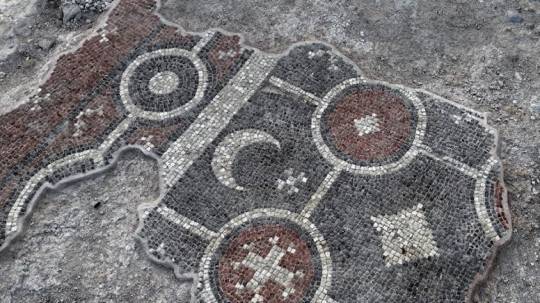


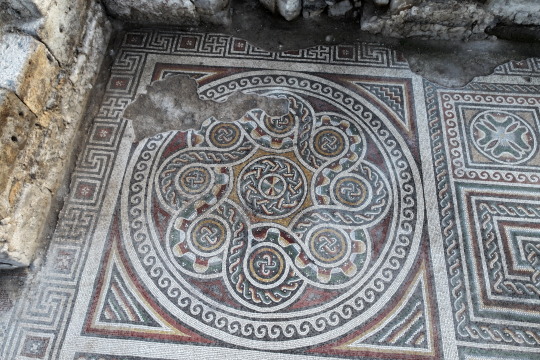

#The Largest Ancient Floor Mosaic in Turkey Uncovered#Cappadocia#Central Anatolia Region#mosaic#art#artist#art work#art world#art news#ancient artifacts#archeology#archeolgst#history#history news#ancient history#ancient culture#ancient civilizations#roman history#roman empire#roman art
195 notes
·
View notes
Text

LIBRARY OF CELSUS - TURKEY
#library of celsus#biblioteca#ancient roman#building#edificio#ancestral romano#ephesus#efesios#anatolia#selçuk#izmir#turkey#turkiye#turquia#europe#europa
133 notes
·
View notes
Text
Artemis Quick Facts
Some of my notes from the books and papers I've read about Artemis.
In the 2nd century at the capital of the Roman province of Asia, Ephesus, Artemis was publicly declared to be "forever the greatest of all the gods".
Her name's etymology is unknown, likely pre-Greek. Her name was popularly believed to mean "healthy", meaning she makes people feel safe and healthy.
Artemis was extremely popular goddess, one of the most popular Greco-Roman gods.
Pausanias notes: "But all cities worship Artemis of Ephesus, and individuals hold her in honor above all the gods…" (4.31.8)
Dr. Rietveld described Artemis Ephesia as an "universal goddess".
Artemis subsumed and was amalgamated with many goddesses, including Kybele, Hekate, and Isis.
She was widely seen as a compassionate and loving god, as she’s always willing to listen and respond to the needs of her people.
She was popularly seen as a goddess of protection and life.
She was famous throughout the Roman Empire for her vivid manifestations, in real life and in dreams.
Hence many sanctuaries, shrines, altars, and temples were built in her honor.
From countless thanksgiving writings she was called "Our Lady".
Her sanctuaries and temples were typically asylum sites.
She's the only Greco-Roman god with the Zodiac on her cult image.
Hence as "Queen of the Cosmos" she has transcendent powers over the cosmos, and Fate.
As Mistress Salvation, Artemis can save her people from their unfortunate fate. It's possible that through the mysteries she can give people a blessed afterlife.
The relationship between Artemis and her worshippers was a divinely directed covenant relationship, born out of genuine affection towards Artemis.
Popularly Called: Queen of the Cosmos, Heavenly Queen, Savior, Our Lady, Mistress Salvation, and Fate Goddess.
Thank you for reading, I hope you enjoy this and learned something new about Artemis.
Sources:
James Rietveld’s “Artemis of the Ephesians”
Mary Gabrielle Galvin "BIOΣ ~ APTEMIΣ"
Richard Oster’s “The Ephesian Artemis as an Opponent of Early Christianity”
Margaret C. Mowczko’s “The Regalia of Artemis”
Paschidis' "Artemis Ephesia and Herakles"
Chaniotis' "Megatheism"
#artemis#greek gods#hellenic pantheon#ancient rome#diana goddess#roman history#anatolia#asia minor#ancient greek#roman mythology#classical mythology#classical period#hellenism#ephesus#ionia#greek mythology
148 notes
·
View notes
Text


The Asclepieion of Pergamon, Turkey.
2024 © Moon and Serpent
17 notes
·
View notes
Text

Pillar 43: Vulture Stone, Göbekli Tepe
37 notes
·
View notes
Note
Hello, I'm a new reader of your fics and found you through AO3, after reading your fic where Apollo n Poseidon are punished with mortality and King idk how to spell his name was talking about getting his daughter married made me wonder about how Greek Marriages and Courtships work/how they were performed and the actual marital rites ofc
Love your work, looking forward to your response •u•
Okay okay, so this requires a lot of know-how and I most definitely don't know everything so this is what I know:
Courtships differed from city-state to city-state. But overall I think they all shared one common factor - a courting gift. Courting gifts were used to basically show off a guy's status in the world, and the better the gift the better chance he had at winning the marriage.
This is actually exemplified in the myth of Cassandra and Apollo! Apollo's courting gift was the gift of prophecy, which Cassandra accepted, ergo confirming their courtship (their relationship was also considered to be a type of marriage btw! Cassandra would have been one of Apollo's 'wives', like the Pythia (essentially married to her job aka Apollo), Cyrene (was literally married to him; eloped with him), or the Muses (his immortal companions) even though they weren't like. married married. they weren't married like Zeus & Hera are, or Hades & Persephone. it was a symbolic one, or even an emotionally-bonded one.
So big gift = better chance at winning her hand. cool.
NOW I WOULD LIKE TO INTERRUPT OUR BROADCAST ON ANCIENT GREECE AND TURN OUR ATTENTION TO COURTSHIPS IN THE MYTHS :D
I've already discussed Apollo&Cassandra, but there are plenty more courtships going on.
Admetus & Alcestis, for one! Odysseus & Penelope! Admetus and Odysseus both had to complete a set task to be seen as "worthy" of marrying their respective wives.
For Admetus, it was yoking a bull and lion to a chariot and riding it into Alcestis's dad's kingdom (which he did with Apollo wingmanning him bless their souls) and for Odysseus, he completed various physical exercises (like a race) and won!
So I guess the overarching message about Greek courting/marriage rituals is the guy has to prove how much of a rich badass he is, and if he can't show off his wealth (like Odysseus), he's gotta make up for it with EXTRA badassness.
As for the marriage itself, it also depended on the region. And it's A Lot so I would recommend skimming this wikipedia article on it and then looking deeper into various other websites - just looked it up, and there are quite a few. I would nail down the main similarities between them as the Facts and the extra info as Potential Facts (my usual method of research - and if the info in corroborated in an informative source, then it is also Fact)
I also see you mentioned Proclia and Laomedon, and what he would have had to do for her marriage. I did find this website on Anatolian marriage customs (since they are in Anatolia and not Greece), but I don't know how reliable it is. If there's anybody out there who knows more, shoot it at me! :D
And thank you anon! :D I promise I have more in store, just working on getting the next couple Hunger Games AU chapters done before moving on to the Delphic fic! :D
#the oracle speaks#ancient greece#anatolia#marriage#courting#anon ask#ask and replies#asked and answered
8 notes
·
View notes
Photo

When speaking about the Oracles of Apollo, we often just mention the most famous oracle of Delphi with its Pythia or the oracle of Phocis with the Mount Parnassus nearby. However, Apollonian cults across the Ancient Mediterranean had not one or two, but more oracles out of which some major ones are: Delphi, Didyma, Hierapolis, and more - they were scattered across Mainland Greece and Asia Minor.
The oracle of the Ancient Didyma is one of these major sites that has had just as interesting of a history of divinatory practices as any other one of Apollo’s oracles.
Oracle of Didyma, first properly mentioned in the Homeric Hymn to Apollo, is a sanctuary located in the town Didim of Ancient Anatolia, Asia Minor (current Turkey), now formally known as Yenihisar. The name of the place is of unclear origin: some researchers suggested Greek origins, seeing that dydimos means “twin” and the association with Apollo and Artemis is obvious, but Artemis’ cult of Didyma had no connections nor mirroring of that of Apollo. Others suggested Zeus as the “partner” God of Apollo at the site - but we have so far found no evidence of there being a Zeus Didymos cult at any point of Ancient cultic activity. Fontenrose suggested that the name must be Carian (Anatolian language) and go along with other Anatolian place names: Sydima, Idyma, Loryma, Kibyma, and such.
The earliest archaeological finds so far discovered at the location site date the cult back to the 8th century BCE, possibly following the Ionian conquest over these Carian lands. The earliest dated pieces of pottery found in Didyma link us back to the 14th century BCE and the Mycenean civilization. Ancient writers, such as Pausanius, claim that the oracle has operated since the 11th century BCE, long before the Ionic invasion, but we are yet to find evidence to back up that claim.
As of current, the city-sanctuary is attested to the Ionian cult of Apollo and is located around 10 kilometers South from the city of Miletus.

While the structural identity of the temple is incredibly interesting and doubles the temple at Delphi in a lot, I will only mention some peculiarities that the Didyma temple of Apollo had: a temenos (a protective wall around a sacred place), a stoas (freestanding surrounding collonade), a circular altar, a naiskos (small inner altar with a pediment), a chresmographeion (office of the oracle), and a sacred well preceding the temple.
Interestingly enough, the temple of Apollo at Didyma, as many scholars agree, was likely built with the aim to create an underground adyton, or inner shrine. Archaeological research and astronomical events observed at the site show that the sanctuary, built slightly differently from other Apollonian oracles in terms of its stellar orientation, was probably meant to face the rising of the constellation of Lyra.
It is possible that the temple was unroofed in both Archaic and Hellenistic age, when the building went through major rebuilding. Interestingly enough, the site of Didyma had musical and drama contests held annually but lacked a theater or an odeion.

The oracle of Didyma, though at first one of the two most popular oracular sites in Asia Minor, has seemingly gone through a decline after the destruction of the temple by Persians in the 5th century BCE. It has been through an uprising in the Hellenistic era with a following decline as Christianity spread, rendering the temple and the oracle unused as late as 3rd century AD.
Unfortunately, the information on the divinatory practices at the site of Didyma is not as well preserved as the information at other sites, such as the oracle of Delphi. We do know that the temple had a priest or a priestess to deliver versed prophecies - the gender of the deliverer of prophecies, through, is unknown.
Generally, there are two main types of divination that have been attested as used at the Didyma temple: mantic trance and cleromancy

We do not know enough to state anything on the divinatory process involving mantic trance at the site during the Archaic age, as all evidence so far has been inconclusive. However, there are surviving inscriptions and writings that show the form of divinatory delivery as used at the site in the post-Archaic period, after the renown revival of the temple by Alexander the Great. The oracle, whether a man or a woman, delivered the prophecies likely directly in form of a dactylic hexameter. Some researches supposed that every Apollonian oracle worked this way, though we do know that some of them were specific about the gender of the oracle - not Didyma.
Perhaps the latter has something to do with the legendary hoi Branchidae, priests tending to the temple of Apollo at Didyma; said to root from Branchus, the God’s old lover.
The oracle of Delphi, a site that, according to geological investigations, likely did have a chasm under the bedrock that could indeed leak vapors into the room of the temple, is different from the oracle at Didyma as the Anatolian temple lacks same volcanic geology. It is thus unclear if the oracle of Didyma fell into mantic trance as it is at all or perhaps used different methods of entering it.
In fact, it is still unclear whether the very concept of a mantic trance was that prevailing over other divinatory types. The requests for the Pythia were, for example, so constant that other types of divinatory practices were constantly used at Delphi. As for Didyma, there is another divinatory method that researchers have so far found evidence of being used.

Astragali, the animal bone knucklebones, have been found across all divinatory centers of the Ancient world. Traditionally made out of bones of ugulates (pigs, sheep, goats, etc.) those lots had numerical significance as they were split into named groups and attested numbers each. It is unclear why specific animals only were used for making astragali, though there’s been stastical research that showed certain bones of certain animals, when shaped correctly, gives better, more equal results when thrown as dice.
As a divinatory tool, astragali possessed a degree of uncertainty to them as they could be modified to change the outcome of the draw; however, some researchers state it was believed that the seemingly random outcome of the draw ensured the diviner bears no influence on the outcome of said draw.
Astragali are sometimes believed to be secondary to oracular advice, and this assumption is based on a few factors. Seeking out oracular help included involving oneself into an expensive and time-consuming procedure that included sacrificing a whole sheep or goat, buying a honey cake for an offering, and going through an extensive consultation; that, combined with how rarely oracles of Delphi, Didyma, and other sites spoke added on to the subjective higher validity of the process, though there’s no proof one way of divination had an actual “better” effect on the results received than the other.
Ancient Anatolia has known divination by what later was called astragali from as long ago as the Copper Age (5,000 - 3,000 BCE) with prominence in the Anatolian city of Alisar, modern Turkey. Middle Bronze Age (2,100 - 1,550 BCE) and Late Bronze Age (1,550 - 1,200 BCE) dated finds of astrogali near Aphrodisias, Turkey, and Beycesultan neared the location of Didyma, pointing out the possible usage of the knucklebones at the site, too. Local Hittites have used astragali as oracular devices since the 14th century BCE, and the tradition seemed to continue on until it changed somewhere between Bronze and Iron age.
The Archaic finds in Ancient Anatolia point out that the usage of astragali has been quite consistent both in the temple to Apollo and the temple to Artemis in Ephesus alongside its use in different local sancturies. The knucklebones found were made out of wood, bones, and sometimes glass - inscribed, clear, and modified alike. Most of the astragali found at the site of Didyma were modified by lead, thus heavy, and had inscriptions on them that point out that the knucklebones bore messages to the inquirer.

One of the most fascinating parts about the history of divination at the site of Archaic Didyma is that the delivery of responses from the Deity was, apparently, direct - not a very common happening across the Greek Apollonian temples. Usually, the delivery would be done through a medium though inscriptions from Didyma use third (”the God said...) and first (”I said...”) person to describe messages given by, apparently, Apollo. Herodotus marks an event where the men of Kyme asked the oracle for advice and, after receiving a dissatisfactory reply, have continued to ask across other oracles of the region, eventually growing angry and disturbing the birds nesting in the walls of one of the temples. That, according to the historian, angered the God enough to speak to the intruders directly and request to never come back. Whether true or not, this does show that at Didyma, the belief persisted that Apollo could deliver messages personally and directly.
Another inscription found at Didyma also points out that the God spoke to the prophet directly; Delphic and Lebadeian oracles occasionally spoke spontaneous utterances directly to the oracles, too. However, the incident of a God speaking to a mortal directly is still a rarity in Ancient Greek worldview.
Sources and further reading: 🏺 🏺 🏺 🏺
#HISTORIA 📔#ancient anatolia#ancient greece#ancient history#ionian greece#cult of apollo#temple of apollo#oracle of apollo#apollo#divination
97 notes
·
View notes
Photo

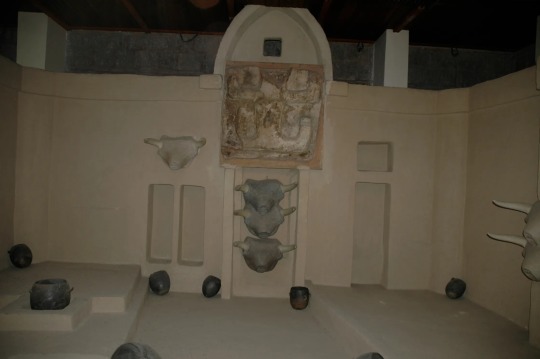
Representation of a ritual scene in Çatal Huyuk, Anatolia, we are not sure about the details of the religious life of this period, but from the archaeological remains it is believed in the prominence of a female deity and the cult of a male represented by the bull, always present in the shrines As for domestic animals like the ones in the photo, we imagine some kind of shamanist in addition to the cult of the dead, often through exhumed and often decorated skulls (a cult that still occurs today in some parts of the world).
71 notes
·
View notes
Text
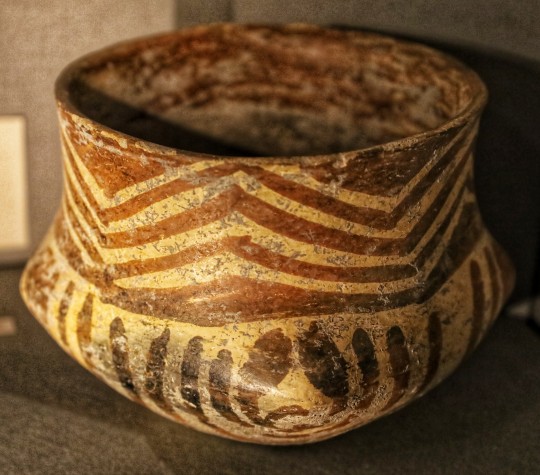

Anatolian Calcholithic 'Square Bowl', 6th Millennium BCE, The Fitzwilliam Museum, Cambridge
#prehistoric#prehistory#ice age#stone age#bronze age#copper age#iron age#neolithic#mesolithic#calcholithic#paleolithic#pottery#prehistoric pottery#anatolia#Cambridge#pottery fragments#ancient pottery#archaeology#relic
82 notes
·
View notes
Photo

Bust of Alexandros of Aphrodisias, Aphrodisias, Aydın, Turkey
Afrodisias’lı Alexandros Büstü, Afrodisias, Aydın, Türkiye
Alexander of Aphrodisias (Greek: Ἀλέξανδρος ὁ Ἀφροδισιεύς; fl. 200 AD) was a Peripatetic philosopher and the most celebrated of the Ancient Greek commentators on the writings of Aristotle. He was a native of Aphrodisias in Caria, and lived and taught in Athens at the beginning of the 3rd century, where he held a position as head of the Peripatetic school. He wrote many commentaries on the works of Aristotle, extant are those on the Prior Analytics, Topics, Meteorology, Sense and Sensibilia, and Metaphysics. Several original treatises also survive, and include a work On Fate, in which he argues against the Stoic doctrine of necessity; and one On the Soul. His commentaries on Aristotle were considered so useful that he was styled, by way of pre-eminence, "the commentator" (ὁ ἐξηγητής).
Afrodisiaslı İskender (Antik Yunanca: Ἀλέξανδρος ὁ Ἀφροδισιεύς), Peripatetik filozof ve Aristoteles'in yazıları üzerine Antik Yunan yorumcuları arasında en ünlü olanıydı. Karya'da Afrodisias'ın yerlisiydi ve 3. yüzyılın başlarında Atina'da yaşadı ve öğretmenlik yaptı. Burada Peripatetik okulunun başı olarak görev yaptı. Aristoteles'in eserleri üzerine birçok yorum yazdı; Kıyas, Topika, Meteoroloji ve Metafizik bunlardandır. Birkaç orijinal eseri de günümüze ulaşmıştır ve Stoacı zorunluluk öğretisine karşı çıktığı bir çalışması Kader Üzerine ve biri Ruh Üzerine. Aristoteles hakkındaki yorumları o kadar yararlı kabul edildi ki, "yorumcu" olarak tanındı.
#Antik#ancient#ancient rome#ancient cities#Ancient Anatolia#phylosophy#philosopher#filozof#felsefe#antik kent#bust#büst#afrodisias#antik anadolu#anadolu#anatolia
3 notes
·
View notes
Text
The ancient city of Kibyra is a true treasure trove of historic remains that once rivaled the famous Lycia! Discover how this rising city-state managed to establish itself outside the boundaries of Lycia and become a regional power, and how it was able to establish a federation with other towns.
24 notes
·
View notes